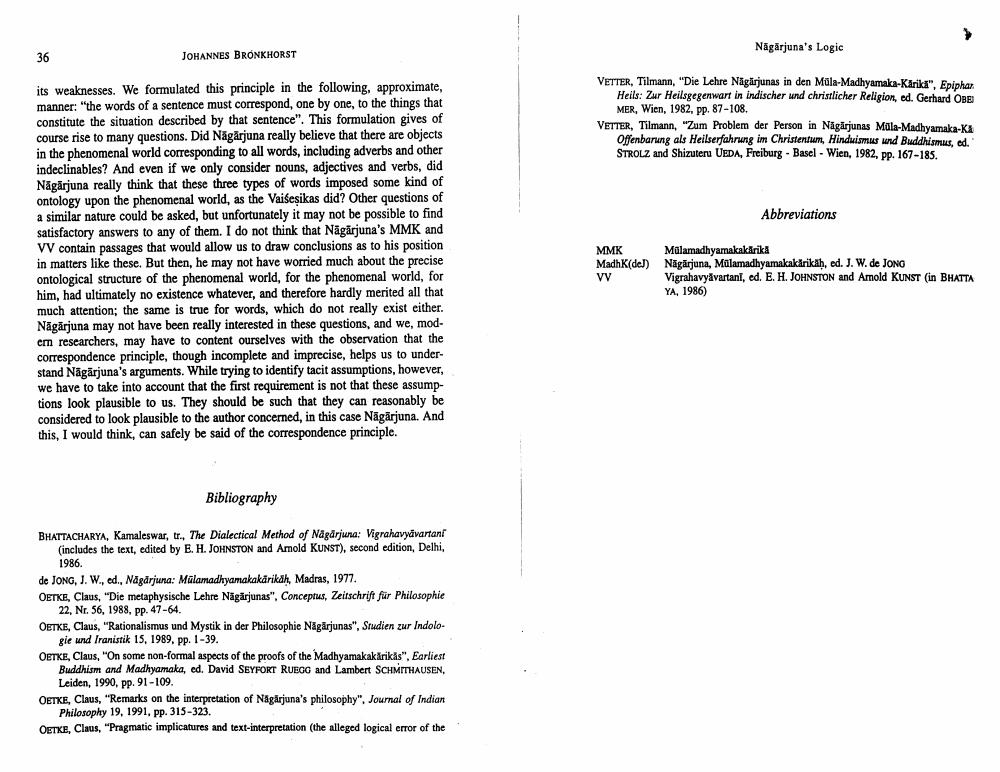Book Title: Nagarjuna Logic Author(s): Johannes Bronkhorst Publisher: Johannes Bronkhorst View full book textPage 5
________________ JOHANNES BRONKHORST Nagarjuna's Logic VETTER. Tilmann, "Die Lehre Nagarjunas in den Mula-Madhyamaka-Karika". Epiphan. Heils: Zur Heilsgegenwart in indischer und christlicher Religion, ed. Gerhard OBEJ MER, Wien, 1982, pp. 87-108. VETTER, Tilmann, "Zum Problem der Person in Nagarjunas Mula-Madhyamaka-Ka Offenbarung als Heilserfahrung im Christentum, Hinduismus und Buddhismus, ed. STROLZ and Shizuteru UEDA, Freiburg - Basel - Wien, 1982, pp. 167-185. Abbreviations its weaknesses. We formulated this principle in the following, approximate, manner: "the words of a sentence must correspond, one by one, to the things that constitute the situation described by that sentence". This formulation gives of course rise to many questions. Did Nagarjuna really believe that there are objects in the phenomenal world corresponding to all words, including adverbs and other indeclinables? And even if we only consider nouns, adjectives and verbs, did Nagarjuna really think that these three types of words imposed some kind of ontology upon the phenomenal world, as the Vaisesikas did? Other questions of a similar nature could be asked, but unfortunately it may not be possible to find satisfactory answers to any of them. I do not think that Nagarjuna's MMK and VV contain passages that would allow us to draw conclusions as to his position in matters like these. But then, he may not have worried much about the precise ontological structure of the phenomenal world, for the phenomenal world, for him, had ultimately no existence whatever, and therefore hardly merited all that much attention; the same is true for words, which do not really exist either. Nagarjuna may not have been really interested in these questions, and we, modern researchers, may have to content ourselves with the observation that the correspondence principle, though incomplete and imprecise, helps us to understand Nagarjuna's arguments. While trying to identify tacit assumptions, however, we have to take into account that the first requirement is not that these assumptions look plausible to us. They should be such that they can reasonably be considered to look plausible to the author concerned, in this case Nagarjuna. And this, I would think, can safely be said of the correspondence principle. MMK MadhK(de) VV Mulamadhyamakakarika Nagarjuna, Mulamadhyamakakarikah, ed. J. W. de JONG Vigrahavyavartani, ed. E. H. JOHNSTON and Amold KUNST (in BHATTA YA, 1986) Bibliography BHATTACHARYA, Kamaleswar, tr., The Dialectical Method of Nagarjuna: Vigrahavyavartani (includes the text, edited by E. H. JOHNSTON and Amold KUNST), second edition, Delhi, 1986. de JONG, J. W., ed., Nagarjuna: Mulamadhyamakakarikah, Madras, 1977. OETKE, Claus, "Die metaphysische Lehre Nagarjunas", Conceptus, Zeitschrift fur Philosophie 22, Nr. 56, 1988, pp. 47-64. OETKE, Claus, "Rationalismus und Mystik in der Philosophie Nagarjunas", Studien zur Indolo gie und Iranistik 15, 1989, pp. 1-39. OETKE, Claus, "On some non-formal aspects of the proofs of the Madhyamakakarikas", Earliest Buddhism and Madhyamaka, ed. David SEYFORT RUEGG and Lambert SCHMITHAUSEN, Leiden, 1990, pp. 91-109. OETKE, Claus, "Remarks on the interpretation of Nagarjuna's philosophy", Journal of Indian Philosophy 19, 1991, pp. 315-323. OETKE, Claus, "Pragmatic implicatures and text-interpretation (the alleged logical error of thePage Navigation
1 ... 3 4 5
